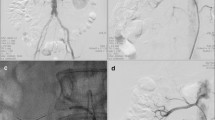Abstract
This study retrospectively reviewed the technical and clinical results of percutaneous transluminal renal artery angioplasty (PTRA) for non-atheromatous renal artery stenosis (RAS) in a Tertiary Renal Referral Centre. Forty-three patients (including 9 children) underwent 49 PTRA procedures for stenoses of 63 arteries over the period 1984–2001 (14 patients had bilateral stenosis treated during one procedure. There were 29 females and 14 males (age range 1–72 years, median 37 years). The etiology of the RAS was classical beaded FMD (medial fibroplasia) in 24, atypical or “variant FMD” with a more focal stenosis (intimal fibroplasia) in 11, neurofibromatosis type 1 (NF) in 7 and Takayasu’s Arteritis in 1. Five of the NF patients had angioplasty for stenoses following vascular repair procedures. A technically good result was obtained in 34/34 arteries with “classical” RAS, 9/13 atypical arteries, 11/15 arteries of NF patients and in the one Takayasu’s case. Clinical follow-up for a mean of 16 months revealed a cure rate of hypertension in classical FMD of 35% with improvement in a further 55%. In the atypical FMD cases, follow-up was obtained on 6 patients with 2 cures and the other 4 demonstrating benefit. There was a better chance of cure in younger patients. In native artery PTRA in children with NF, only 1 out of 3 patients was ‘cured’ post-PTRA, and 2 out of 3 failed. However, in postsurgical stenoses in NF patients 1 out of 4 patients was ‘cured’ and 3 out of 4 improved. In conclusion, classical FMD responds well to PTRA with better results in younger patients. Atypical FMD, especially in children and when associated with NF, is less predictable. Stenoses consequent to revascularization surgery respond well to PTRA.



Similar content being viewed by others
References
GH Anderson N Blakeman DHP Streeter (1994) ArticleTitleThe affect of age on prevalence of secondary forms of hypertension in 4429 consecutively referred patients J Hypertensi 12 609–615
LU Mailloux B Napolitano AG Bellucci M Vernace BM Wilkes RT Mossey (1994) ArticleTitleRenal vascular disease causing end stage renal disease—incidence, clinical correlation and outcome: a 20-year clinical experience Am J Kidney Dis 24(4 622–629
InstitutionalAuthorNameVeterans Administration Cooperative Study Group on Anti-hypertensive agents (1967) ArticleTitleEffect of treatment on hypertension: results in patients with diastolic blood pressure averages 115–129 mmHg JAMA 202 1028–1034
Tegtmeyer CJ, Matsumoto A, Angle JF (1996) Percutaneous transluminal angioplasty in fibrous dysplasia and children. Novick, Scoble & Hamilton. (eds). Renal vascular disease. Saunders London Publ pp 363–383
LJ McCormack HP Dunstan TF Meaney (1966) ArticleTitleA pathologicarteriographic correlation of renal arterial disease Am Heart J 72 188–198 Occurrence Handle10.1016/0002-8703(66)90442-X Occurrence Handle1:STN:280:CCiD3cbmtFc%3D Occurrence Handle5915557
MJ Dillon (1987) ArticleTitleInvestigation and management of hypertension in children; a personal perspective Pediatr Nephrol 1 59–60 Occurrence Handle1:STN:280:By6D38jhsFA%3D Occurrence Handle3153262
C Booth R Preston G Clark J Reidy (2002) ArticleTitleManagement of renal vascular disease in neurofibromatosis type 1 and the role of percutaneous transluminal angioplasty Nephrol Dial Transplant 17(7 1235 Occurrence Handle10.1093/ndt/17.7.1235
E Fossali E Signorini RC Intermite E Casalini A Lovaria MM Maninett LN Rossi (2000) ArticleTitleRenovascular disease and hypertension in children with neurofibromatosis Pediatr Nephrol 14(8–9 806–810 Occurrence Handle10.1007/s004679900260
A Morganti (2000) ArticleTitleAngioplasty of the renal artery: antihypertensive and renal effects J Nephrol 13(suppl)3 S28–S33
CE Grim (1981) ArticleTitlePercutaneous transluminal dilatation: the treatment of choice for renal artery stenosis causing hypertension Am J Kidney Dis 1(3 186–187
CJ Tegtmeyer JB Selby GD Hartwell C Ayers V Tegtmeyer (1991) ArticleTitleResults and complications of angioplasty in fibromuscular disease Circulation 2 suppl 155–61
AL Baert G Wilms A Amery J Vermylen R Suy (1996) ArticleTitlePercutaneous transluminal renal angioplasty: initial results and long-term follow-up in 202 patients Cardiovasc Intervent Radiol 13 22–28
J von Knorring J Edgren M Lepantalo (1996) ArticleTitleLong-term results of percutaneous transluminal angioplasty in renovascular hypertension Acta Radiol 37 (1 36–40
NE Klow D Paulsen K Vatne B Rokstad B Lien P Fauchald (1998) ArticleTitlePercutaneous transluminal renal artery angioplasty using the coaxial technique. Ten years of experience from 591 procedures in 419 patients Acta Radiol 39 (6 594–603
FS Bonelli MA McKusick SC Textor PB Kos AW Stanson CM Johnson PF 2nd Sheedy TJ Welch A Schirger (1995) ArticleTitleRenal artery angioplasty: technical results and clinical outcome in 320 patients Mayo Clin Proc 70 IssueID11 1127–1129 Occurrence Handle7475345
J Klinge WP Mali CB Puijlaert GG Geyskes WB Becking MA Feldberg (1989) ArticleTitlePercutaneous transluminal renal angioplasty: initial and long-term results Radiology 171 IssueID2 501–506 Occurrence Handle1:STN:280:BiaB3c3ntFY%3D Occurrence Handle2523080
RA Davidson Y Barri RS Wilcox (1996) ArticleTitlePredictors of cure of hypertension in fibromuscular renovascular disease Am J Kidney Dis 28 IssueID3 334–338 Occurrence Handle1:STN:280:BymA1MjjtlI%3D Occurrence Handle8804230
M Birrer DD Do F Mahler J Triller I Baumgartner (2002) ArticleTitleTreatment of renal artery fibromuscular dysplasia with balloon angioplasty: a prospective follow-up study Eur J Vasc Endovasc Surg 23 IssueID2 146–152 Occurrence Handle10.1053/ejvs.2001.1559 Occurrence Handle1:STN:280:DC%2BD387ivVKktw%3D%3D Occurrence Handle11863332
RL Chevalier CJ Tegtmeyer RA Gomez (1987) ArticleTitlePercutaneous transluminal angioplasty for renovascular hypertension in children Pediatr Nephrol 1 89–98 Occurrence Handle1:STN:280:By6D38jhsFM%3D Occurrence Handle2978967
S Sharma H Gupta A Saxena (1998) ArticleTitleResults of renal angioplasty in non-specific aorto-eneritis (Takayasu’s disease) J Vasc Interv Radiol 9 IssueID3 429–435 Occurrence Handle1:STN:280:DyaK1c3nvVKlsQ%3D%3D Occurrence Handle9618101
Author information
Authors and Affiliations
Corresponding author
Rights and permissions
About this article
Cite this article
Hughes, R., Scoble, J. & Reidy, J. Renal Angioplasty in Non-atheromatous Renal Artery Stenosis: Technical Results and Clinical Outcome in 43 Patients. CVIR 27, 435–440 (2004). https://doi.org/10.1007/s00270-004-0135-0
Published:
Issue Date:
DOI: https://doi.org/10.1007/s00270-004-0135-0




